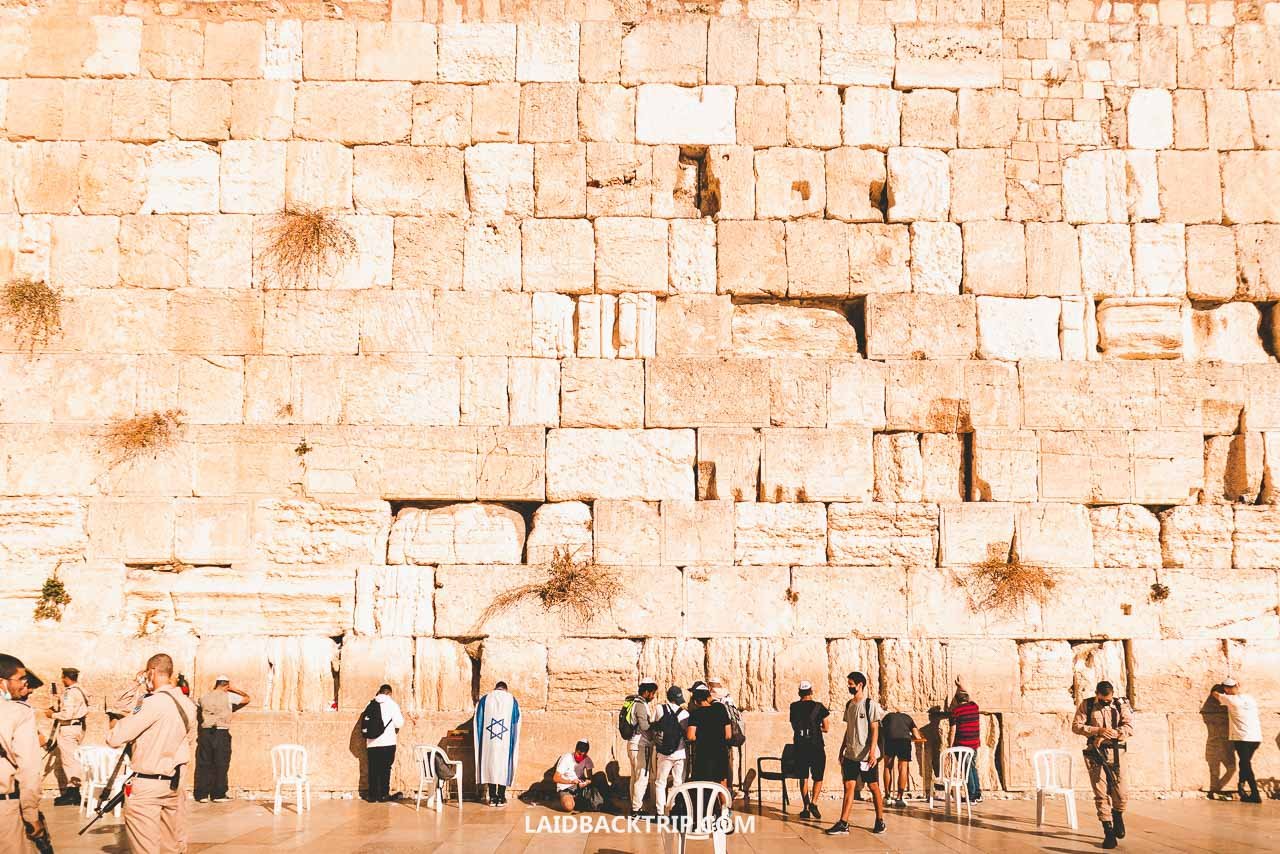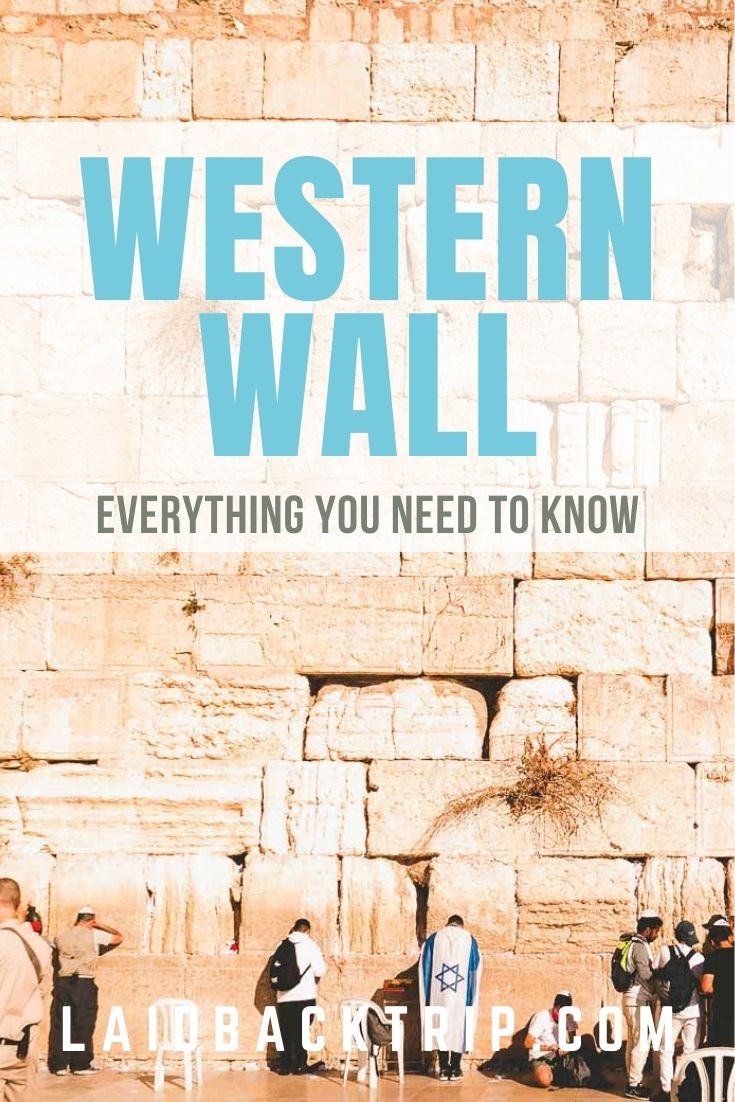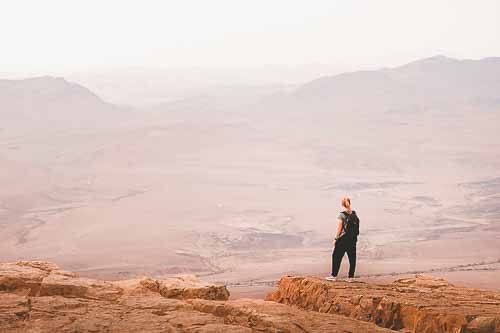How to Visit the Western Wall in Jerusalem
Visit with us the Western Wall, one of the holiest places in the world and a must-visit place in Israel. Our travel guide includes everything you need to know before visiting the Western Wall in Jerusalem. From how to get, what to wear to what to expect, we got you covered.
There's probably no traveler to Jerusalem who does not have the Western Wall, one of the top attractions in the Holy Land, on their bucket list and Israel itinerary.
Although the Western Wall is a holy place mainly for Jewish people, we believe that every visitor who enjoys history, architecture, and learning about different, more traditional lifestyles, will find the site very enticing.
We even believe that if you have more days for exploring Jerusalem, you'll walk past the Western Wall multiple times, and every time, you'll find a few minutes only to stop, observe, and contemplate.
The Western Wall is also known as Wailing Wall, referring to the fact that many Jews come here to mourn over the destruction of the Herod's Temple in the 70 CE and not only over that.
But as they come here to pray in the first place, people of Israel prefer to call the holy place the Western Wall, and we are going to respect that, although, in our home country, we traditionally use the other name.
When we arrived by train from Tel Aviv to Jerusalem, we left our luggage in the hotel room, and could not wait to start exploring the Old City.
We did not even have an exact plan as we could not figure out how much time we would spend at each attraction, and we could read many posts with warnings about queues and long waiting times.
Fortunately, it was not the case at the time of our visit, so we wandered the maze of streets freely, without a rush.
And without even knowing that (one could say we were led by an invisible hand), all of a sudden, we appeared about fifty meters from the entrance to the square, where you can find the famous landmark, the Western Wall.
And yes, although some could point out it is 'just' a wall, we guarantee that you'll be overwhelmed by the atmosphere.
Simply put, together with the Church of the Holy Sepulchre, Dome of the Rock, Via Dolorosa, and Mount of Olives, the Western Wall is among the top attractions in Jerusalem.
In this blog post, we would like to prepare you for visiting the Western Wall.
Our personally curated travel guide includes everything we believe the first-time visitor would like to know to enjoy the site the most, including the often asked questions like where the Western Wall is, how to reach it, what to wear, or what to expect.
History of the Western Wall
You might be wondering why is the Western Wall so significant.
Well, we do not want to bore you with a lot of history, as we believe you'll want to sit in front of the wall and read the fascinating story yourself same as we did.
But we also think that this article would not be complete without at least scratching the surface.
Western Wall is a limestone wall, more than 2000 years old (although it had to be rebuilt), standing on the western side of Mount Temple.
Back in the days, this wall supported Mount Temple, the location of the Second Temple, which was sacred to Jews.
After the temple's destruction by Romans in 70 CE, Jews were banned from Jerusalem, and they had to leave.
Since then, the situation has always been complicated.
As the rulers changed during centuries, Jews had no, limited or full access to the wall, which became an important religious site and a symbol of the Second Temple they lost many centuries ago.
We have to mention that Mount Temple is also a super-important location for Muslims because it is home to Dome of the Rock and Al-Aqsa Mosque, which makes things even more complicated, and the wall is a place of quite regular disputes between believers.
Nowadays, Western Wall is basically a large open synagogue, and the whole plaza in front of it has a hard-to-describe atmosphere that even non-believers can feel.
How to Get to the Western Wall
Getting to the Western Wall is very easy, and there are several access points.
In general, you need to get to the Old City first. The historic center of Jerusalem is accessible via several gates, and it is only up to you which one you'll choose.
If you do not have time for wandering the narrow streets of central Jerusalem, we recommend you enter the Western Wall Plaza via Dung Gate or Zion Gate, which is a bit away.
As we stayed in the northern part of the city, our access point to the Old City was Jaffa Gate.
From here, we basically walked straight all the time until we reached the turn off to an even narrower street that led us directly to the square's entrance.
New Gate is also another alternative, same as Golden Gate or Damascus Gate.
At first, when preparing for the trip, we were quite confused by the number of gates and names, but in the end, we used all of them at some point, so no worries.
Although it does not look like it, navigating around Jerusalem is not that hard.
We were able to get to the Western Wall on foot, but if walking is not your thing or simply short on time, you can get to the closest gate to the wall by rental car or taxi and save some time.
Parking near the Western Wall can be problematic, though, so taking a taxi might make more sense in this case.
Here you will find more information on how to get around Israel.
Staying Safe
Overall we felt safe in Jerusalem and, by extension, in Israel, but the truth is we, as tourists, can never know what is bubbling under the surface.
In general, Israel's complicated history and religious-related problems that have escalated during the centuries resulted in one thing.
A police presence and security checkpoints in the near proximity of the Western Wall is a common thing.
The truth is that when something in Jerusalem happens, it is often nearby this place because it is so crucial to almost everyone - Jews, Christians, and Muslims.
Not long after we departed Israel, we could read in the news that there was an armed attempt to penetrate the security and get to the wall, probably to bring attention to today's situation.
It was weird to read it as our time in Jerusalem felt very peaceful.
Before you get to the Western Wall, you need to walk past the security check involving a metal detector.
It means one thing. Do not pack in your backpack anything that could be considered dangerous, resulting in not being able to visit this wonderful site.
Here you will find more tips on staying safe in Israel.
Travel Insurance
We never leave home without travel insurance that was designed to cover our expenses if something goes wrong during the trip.
Travel insurance protects against theft, flight delays, injury, illness, cancellations, and much more.
World Nomads provides travel insurance for travelers to cover their trip essentials, including sports and adventure activities.
SafetyWing is affordable travel insurance for backpackers, long-term travelers, and digital nomads.
Travel smarter and safer!
What to Wear
As we've already mentioned, although visiting the Western Wall can seem like visiting any other historical site, this is not exactly the truth.
Because of the religious significance and the fact that the whole area is basically a synagogue, you should dress modestly.
It applies to visiting the majority of top attractions in Jerusalem, so it should not be that surprising, and we can only recommend you follow this unwritten rule to ensure you'll be allowed to come nearer to the Western Wall.
All visitors to the Western Wall should wear trousers (no shorts) and a t-shirt with sleeves, definitely not a sleeveless tank top.
The rules are pretty straightforward and not hard to follow at all, as they are, in the end, not that strict.
It might be a bit uncomfortable to be covered in the summer when temperatures are high, so choose breathable materials.
We also had with us a small daypack with a water bottle and a t-shirt with long-sleeves, just in case guards were stricter than we thought.
We also had our mirrorless camera that was altogether with our phone checked the same way as, for example, in the airport.
Don't forget that men need to wear a kippah (Jewish head covering) to access the Western Wall praying area.
If you don't have one, you can borrow it for free at the stall on the access ramp.
Visiting the Western Wall
How's visiting the Western Wall without a guide then? For the most powerful experience, we think it is best to see the wall's front face.
Entrance
That's why we did not walk via Dung Gate, but we arrived via the maze of streets to Haja'y Street, where was the security checkpoint.
Fortunately, we did not have to wait long, and after a while, we were already descending stairs leading to a spacious Western Wall Plaza.
First Impressions
It is incredible how the atmosphere can immediately absorb you.
Traditionally dressed men and women walk around, and even if you are not a religious person, we believe the perfect mixture of everyday life and the majesty of the wall will leave you speechless.
On your left, there are public toilets (ok, that's not that sacred but quite handy, on the other hand), and a bit further, there is an entrance to the Western Wall Tunnels.
If you want to see the tunnels that lead under the wall, it is better to make a reservation.
At the time of our visit, the number of guided tours was limited, so we did not make it to the underground.
You can let us know in the comments below whether it is worth it or not.
Viewing Platform
On the right side, you can see the Mughrabi Gate, which you can later use to enter the Rock Dome area.
Once you orientate yourself in the space, nothing will hold you back from coming nearer to the Western Wall.
At first, we just stood behind the barrier that separates the area close to the wall from the rest of the Western Wall Square.
We watched praying people, traditionally dressed, with holy books in their hands, swaying forth and back.
Men and Women Sections
Later on, we decided to come closer to the wall. It's good to know that men and women pray at their own section at the Western Wall.
The left (bigger) side is reserved only for men, and the right and much smaller part is where only women can go.
It is quite a controversial topic (one of many associated with the Western Wall), but we'll leave it to it. It is simply how it is right now.
On top of that, men must have their heads covered, but it is possible to use a paper skull cap, which is available by the entrance.
The men section felt to us more intense (or orthodox), while the women section was more peaceful and quiet, but that was our first impression.
Later on, we found out that women are not allowed to pray aloud at the site, wear prayer shawls or read from the Torah, which explained a lot.
Here it is necessary to say that if you travel as a heterosexual couple or a multi-gender party, you cannot visit the wall together.
Can you Touch the Western Wall?
If you want, you can touch the wall, pray, and even deposit a written prayer on a piece of paper in the gaps between the large stones.
We could see that some of the papers fell off, but no worries, these fragments are used and deposited in the evening.
It is quite strange that you can even send your prayer online; it will be printed and put on your wall on your behalf. We really do not see much sense in that, though.
How Much Time You Need?
The visit to the Western Wall took us about an hour and a half, but we took it really slowly, sat on the square for a while, used all the photography opportunities we had, and read a bit more about the history.
If you are in a rush, even thirty minutes will do.
When is the Best Time to Visit the Western Wall
The Western Wall site is open year-round, and there are no opening hours. Still, you can choose the best time for visiting the Western Wall.
In general, the busiest time (and best time to watch locals and their habits) is in the afternoon, a few hours before the sun sets.
On the other hand, come early in the morning, when Jerusalem is only waking up if you prefer enjoying a peaceful time for contemplating.
An interesting option is to visit the Western Wall during the Shabbat (it starts before the sunset on Friday and ends on Saturday afternoon) or on the holidays.
It is the time when whole Jewish families visit the plaza, and also many ceremonies like bar mitzvah take place here.
On the other hand, one of the most important things to know before visiting Israel is that Shabbat has a unique set of rules, and one of them is a ban on using digital equipment, such as your camera.
If you have more days in Jerusalem, it is a great idea to visit the Western Wall during different periods, to experience the changing atmosphere the most.
Entrance Fee
Visiting the Western Wall is completely free of charge.
That is awesome, especially for travelers doing Israel on a budget, because this is really not a cheap country.
You only need to buy tickets for the tunnels.
Contributing money is optional.
We could see that a few orthodox Jews ask for money on the square, so it is only up to you whether you want to support their cause or not.
Where to Stay in Jerusalem
We found it best to stay outside the Old City but within walking distance to Jaffa Gate, so everything was still nearby.
Although there are several hotels or hostels very close to the Western Wall, we did not have a budget for paying just for the feeling we are so close to this landmark, but the decision is yours.
There's only one thing many hotels in Jerusalem have in common. They usually cost much more than they should as the quality is not somehow spectacular, but the demand drives rates up, especially in the full season.
Here's our suggestion on where to stay in Jerusalem for every type of traveler.
Budget | De Cardo Hotel - This hotel is where we stayed for four nights in Jerusalem. This hotel is very conveniently located, rooms were clean, nicely designed, and the staff was always very friendly.
Mid-range | Herbert Samuel Hotel Jerusalem - This exceptional hotel is located only a few hundred meters away from the old city. Except for the comfortable rooms, guests can also enjoy relaxing in the wellness center.
Luxury | Waldorf Astoria Jerusalem - If you want to experience something exceptional and your budget does not have a low daily limit, stay in this hotel. The location and overall architecture are simply wonderful.
Travel Resources
Here you can find links to all the travel resources we use and which you might find helpful when planning your next holiday.
Accommodation: When looking for accommodation, we usually search hotels via Booking.com or Hostelworld.
Tours: Although we love to travel independently, some places are better to visit with a guided tour.
We prefer GetYourGuide for its easy-to-use interface and solid reputation. Another great alternative is Viator.
Rental Cars: When going on a road trip, we always use Rentalcars.com, a reliable site for booking a rental car in advance.
Flight Tickets: When looking for flight tickets, you can search Skyscanner to find the best price.
Travel Insurance: World Nomads and SafetyWing cover against risks of travel.











